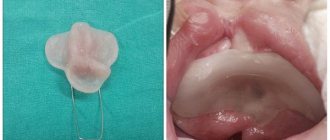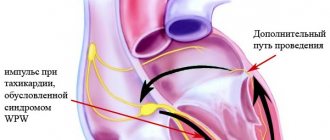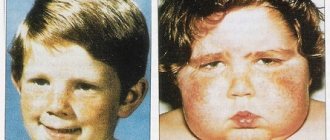Hospitalization and treatment under the compulsory medical insurance quota. More details after viewing the pictures.
Arnold-Chiari malformation in adults is accompanied by the descent and exit through the foramen magnum of the brain structures that are located in the posterior cranial fossa. At the same time, nearby brain structures are compressed. This leads to disruption of the outflow of cerebrospinal fluid and the development of hydrocephalus. Most often, the signs of Arnold-Chiari malformation are combined with syringomyelia. This is a chronic disease of the central nervous system, which is accompanied by the formation of cavities in the medulla oblongata and spinal cord.
Neurologists find it difficult to establish the true causes of the disease. Symptoms of Arnold-Chiari malformation may occur due to shrinkage of the posterior fossa. As a result, the brain structures gradually exit through the foramen magnum. The cause may also be an increase in brain size due to hydrocephalus or traumatic brain injury.
Definition
Arnold Chiari syndrome type I consists of the descent of the lower part of the cerebellum - the cerebellar tonsils - into the foramen magnum and spinal canal in the absence of other malformations associated with the spinal cord. Sometimes it is believed that the prolapse of the cerebellar tonsils should be more than 5 mm, sometimes more than 3 mm, for others the prolapse begins at 0 mm, when the tonsils are at the level of the border of the foramen magnum, in the presence of an appropriate clinical picture.
Figure 1.- The diagram shows the descent of the cerebellar tonsils and the increase in the supracerebellar space due to the displacement of the entire cerebellum towards the foramen magnum. Arnold Chiari I syndrome.
Causes
The etiology is not reliably known. According to some neurologists, the appearance of Arnold Chiari malformation in a child is due to a decrease in the size of the cranial fossa, which predisposes structures to exit through the hole as they grow. Other experts associate the pathology with an increase in the size of the brain, which contributes to the pushing out of the contents of the cranium.
Hydrocephalus, characterized by dilatation of the ventricles, provokes an increase in the clinical picture. The manifestation of the disease can be caused by a traumatic brain injury, aggravating the herniation. This is due to improper development of the bone structures of the corresponding area.
Symptoms
The clinical picture of Arnold Chiari I syndrome can be varied, the most common symptoms (from more frequent to rarer): headaches, pain in the cervical spine, paresis in the limbs, visual impairment, pain in the limbs, paresthesia, sensory disturbances, dizziness, swallowing disorders, lower back pain, memory impairment, gait disturbance, pain in the thoracic spine, imbalance, dysesthesia, difficulty expressing thoughts and finding words, sphincter disorders, insomnia, vomiting, loss of consciousness, trembling.
Symptoms and clinical picture
Many people suffering from this developmental pathology may not even be aware of its presence. Usually, they are diagnosed accidentally and do not require any treatment.
The remaining patients have more or less severe symptoms of the disease. The disease is accompanied by pain in the cervical-occipital region of the head, which tends to intensify with coughing, hiccups, and also with sneezing. A neurologist finds a decrease or complete absence of pain and temperature sensitivity of the upper extremities, muscle weakness and spasticity of the extremities. Also, fainting and dizziness are observed, there may be decreased vision, episodic apnea, and involuntary rapid eye movement. An increase in intracranial pressure is characterized by morning pain in the head, a feeling of hissing and ringing in the ears. Deterioration in coordination is manifested by tremor of the upper or lower extremities. As the disease progresses, the patient develops problems with urination, weakness and general fatigue increase. During movement, the clinical picture becomes more vivid.
Arnold Chiari types
There are 4 classical types (I, II, III, IV) and two recently described types (“0”, “1.5”):
Type I Prolapse of the cerebellar tonsils without any other malformation of the nervous system.
Type II Cerebellar tonsil prolapse with a neurovertebral malformation in which the spinal cord is attached to the spinal canal.
III type. Cerebellar tonsil prolapse with occipital encephalocele and cerebral abnormalities in Arnold Chiari II syndrome.
IV type. Dropping of the cerebellar tonsils, aplasia or hypoplasia of the cerebellum associated with aplasia of the tentorium.
“0” type Currently, cases of a clinical picture characteristic of Arnold Chiari Syndrome I, without prolapse of the cerebellar tonsils, have been reported.
“1.5” type. Recently, Arnold Chiari Syndrome 1.5 has been described with descent of the cerebellar tonsils and descent of the brain stem into the foramen magnum.
Therapy
Treatment of Arnold-Chiari malformations depends on the severity of neurological symptoms. Conservative therapy includes non-steroidal anti-inflammatory drugs and muscle relaxants. If conservative therapy is unsuccessful within 2–3 months or the patient has a severe neurological deficit, surgical intervention is indicated. During the operation, compression of the nerve structures is eliminated and cerebrospinal fluid flow is normalized by increasing the volume (decompression) of the posterior cranial fossa and installing a shunt. Surgical treatment is effective, according to various sources, in 50–85% of cases; in the remaining cases, symptoms do not completely regress. Surgery is recommended before severe neurological deficits develop, as recovery is better with minimal changes in neurological status. Such surgical treatment is performed in almost every federal neurosurgical center in Russia and is carried out as part of high-tech medical care under the compulsory medical insurance system.
Patients with Arnold-Chiari malformation types 0 and 1 may not even know they have this disease throughout their lives. Due to prenatal diagnosis of MAC types II, III and IV, children with this pathology are born less and less often, and modern nursing technologies can significantly increase the life expectancy of such children.
Sources
- Arnold-Chiari malformation. Prenatal and clinical observations Avramenko T.V., Shevchenko A.A., Gordienko I.Yu. Bulletin of VSMU. –2014. - No. 2. - P. 87–95.
- Bogdanov E.I. Arnold-Chiari malformation: pathogenesis, clinical variants, classification, diagnosis and treatment / E.I. Bogdanov, M.R. Yarmukhametova // Vertebroneurology. - 1998. - No. 2–3. — pp. 68–73.
- Arnold-Chiari malformation: classification, etiopathogenesis, clinic, diagnosis: (literature review) / L. A. Dzyak [et al.] // Ukrainian Neurosurgical Journal. - 2001. - No. 1. - P. 17–23.
- Egorov O. E. Clinic and surgical treatment of Chiari malformation type 1 / O. E. Egorov, G. Yu. Evzikov // Neurological Journal. - 1999. - No. 5. - P. 28–31.
- Kantimirova E. A., Schneider N. A., Petrova M. M., Strotskaya I. G., Dutova N. E., Alekseeva O. V., Shapovalova E. A. Occurrence of Arnold-Chiari anomaly in neurologist practice. Neurology, Neuropsychiatry, Psychosomatics. — 2015. No. 4. — pp. 18–22.
- Latysheva V. Ya., Olizarovich M. V., Filyustin A. E., Gurko N. A. Clinical and tomographic relationships in Arnold-Chiari syndrome. International Journal of Neurology. 2011; (7): 6–11.
- Yurkina E. A. Clinical, neurological and neuroimaging comparisons of anomalies of the craniovertebral region in adults. Dissertation for the degree of candidate of medical sciences St. Petersburg, 2021.
Theories about the cause of cerebellar tonsil prolapse
Prolapse of the cerebellar tonsils can be the result of the tension that a particular malformation places on the spinal cord, with the exception of Arnold Chiari syndrome type I, in which prolapse of the cerebellar tonsils is the only disorder, and there are different theories about the cause of this disorder:
– Traditional theories:
- Hydrodynamic: prolapse of the cerebellar tonsils is a consequence of impaired circulation of the cerebrospinal fluid.
- Malformation: The theory about the small size of the foramen magnum, which provokes the descent of the tonsils into the spinal canal.
– The theory of spinal cord tension according to Filum System ®:
Dr. Miguel B. Royo Salvador's theory views the prolapse of the cerebellar tonsils in Arnold Chiari Syndrome I as a result of abnormal tension on the spinal cord due to an abnormal and tight ligament called the filum terminale. The terminal filament is not visible in the photographs.
Figure 2. - MRI of the patient at 8 and 20 months, in the second image you can observe the prolapse of the cerebellar tonsils, which appeared after the first MRI. Huang P. “Adquired” Chiari I malformation. J. Neurosurg 1994. This indicates that, in addition to the hereditary and genetic factor, there is a factor of acquired disease.
Factors influencing the development of Arnold Chiari I Syndrome
The main factors involved in the development of Arnold Chiari Syndrome I are as follows:
- Family Predisposition: Tension of the nervous system due to an abnormally tight filum terminale, which we call filum terminale disease, leads to prolapse of the cerebellar tonsils. This pathology is genetic and can be inherited.
- Sudden increase in tension on the spinal cord: After a fall or spinal injury, existing tension on the spinal cord—filum terminale disease—may increase. In these cases, due to the stronger tension, the descent of the cerebellar tonsils or compression in the foramen magnum may increase, which will affect the growth of symptoms. Trauma, in this case, is not the cause of the development of Arnold Chiari syndrome, it is only a trigger for a sudden deterioration of the condition due to an increase in tension force.
Pathogenesis
The pathophysiology is usually based on a discrepancy between the size of the posterior cranial fossa and the structures of the nervous system present in it, as well as:
- development of anomalies of the cervical vertebral bodies, including their splitting, most often of the first (this development mechanism occurs in 5% of cases), assimilation of the atlas - fusion of the cervical vertebra with the occipital bone;
- displacement of the cerebellar structures during the period of rapid brain growth with slowly growing skull bones;
- hydrocephalus – excessive accumulation of cerebrospinal fluid;
- syringomyelia is an abnormal process of development of cavities in the spinal cord;
- myelomeningocele – a congenital defect in the development of the neural tube;
- various congenital diseases, including platybasia , Dandy-Walker anomaly .
Complications of Arnold Chiari Syndrome I
Complications from prolapse of the cerebellar tonsils may depend on the degree of tension or on tissue compression in the occipital region (compression of the tissues of the cerebellar tonsils and the spinal cord stem due to limited space in the occipital space).
- Deterioration in quality of life: with Arnold Chiari I syndrome, headaches, dizziness, pain in the back and limbs, paresis, swallowing or sensitivity disorders, cognitive impairment, visual or gait disturbances can become chronic, increase in intensity, each time worsening the patient’s condition, limiting it normal lifestyle.
- Chronic pain: Patients may need treatment in a pain management unit because conventional anti-inflammatory and pain medications may not be effective in treating headache attacks and other symptoms.
- Sudden death: the spinal cord stem controls cardiorespiratory functions; if the cerebellar tonsils put pressure on it, breathing disorders (apnea, respiratory arrest, and even sudden death of the patient) may occur during sleep. That is why timely diagnosis and early treatment are so important.
Treatment
If a Chiari type 1 malformation is incidentally detected on brain magnetic resonance and without symptoms, no special treatment is required. However, given the possible progression of the disease, periodic monitoring by a neurologist is necessary to identify hidden symptoms and conduct additional tests. With the appearance of neurological symptoms and progression of the disease, the question of surgical treatment in a neurosurgical hospital may arise: decompression of the posterior edge of the occipital bone, resection of the upper cervical vertebrae, plastic surgery of the membranes, etc. With the development of obstruction of the cerebrospinal fluid pathways, progression of syringomyelic cysts, etc. - CSF shunt operations . In the case of minor symptoms and no progression of the disease, surgical treatment is not always advisable. In such situations, patients (adults and children) should be under the supervision of a neurologist, take medications (anesthesia, muscle relaxants), physiotherapeutic treatment methods, and regularly undergo MRI monitoring of the brain and spinal cord so as not to miss the progression of the disease.
Treatment of Arnold Chiari Syndrome I
Typically, neurosurgical treatment is used for Arnold Chiari Syndrome I with/without syringomyelia. Currently, decompression or craniotomy of the foramen magnum is the standard treatment for this diagnosis in most medical centers in the world. It is usually prescribed in cases where the symptoms cause more damage and mortality than the natural progression of the pathology.
However, since 1993, after the publication of the doctoral dissertation of Dr. Royo Salvador, who linked the tension of the entire nervous system with the filum terminale, the tension of which provokes, among other diseases, the prolapse of the cerebellar tonsils, a new treatment was developed, etiological, that is, eliminating the cause of the disease with surgical dissection of the filum terminale, which removes the pathological tension mechanism.
Our technique of filum terminale dissection is minimally invasive and is prescribed in all cases of filum terminale disease, both symptomatic and asymptomatic, and as early as possible, since the risks are minimal and much lower than from the pathology itself, in addition, this treatment stops further development of the disease.
Cutting the filum terminale with the Filum System® technique:
Advantages
1. Eliminates the cause of Arnold Chiari Syndrome I and associated pathologies.
2. Eliminates pressure in the foramen magnum and with it the risk of sudden death.
3. 0% mortality, without consequences in more than 1500 patients operated on using the Filum System® method.
4. With minimally invasive technique, surgical time: 45 minutes. Short stay in the clinic. Local anesthesia. Short period of post-operative recovery without restrictions.
5. Improves symptoms, stops the prolapse of the cerebellar tonsils.
6. Eliminates the risk of hydrocephalus due to prolapse of the tonsils.
7. Improves blood supply to the entire nervous system and, at the same time, cognitive capabilities, which may suffer due to spinal cord tension.
Flaws
1. A small suture in the coccyx area; complications such as suture infection and hematoma in the operation area are possible.
2. Improvement in spasticity is sometimes mistaken for decreased strength in the limbs.
3. During the process of restoration and improvement of sensitivity, unpleasant sensations may appear, which are usually mistaken for undesirable consequences.
4. With improved blood supply to the brain, brain activity may increase and mood swings may occur during the initial post-operative period.
Occipital craniectomy:
(Decompression of the foramen magnum)
Advantages
1. Avoiding the risk of sudden death.
2. The condition of some patients improves.
Flaws
1. Does not eliminate the cause of the disease.
2. Mortality from 0.7 to 12%, a higher percentage than sudden death with spontaneous development of the disease.
3. Aggressive surgery, crippling and possible consequences.
4. Small percentage of improvement and for a short period of time.
5. Neurological deficit: depends on the location of the injury: Emiparesia (paralysis of half the body from 0.5 to 2.1%. Changes in visual space from 0.2 to 1.4%. Changes in speech from 0.4 to 1%. Lack of sensitivity from 0.3 to 1%. Lack of balance, difficulty walking from 10 to 30%.
6. Postoperative intracerebral hemorrhage in the operated area, epidural hematoma, intra-axial hemorrhage, which can cause neurological deficit or worsening of a pre-existing deficit (0.1 to 5%).
7. Brain edema, depending on the process and situation, the risk reaches 5%.
8. Superficial, deep or intracranial infection, risk from 0.1 to 6.8%, with the formation of a brain abscess, aseptic-septic meningitis.
9. Hemodynamic changes due to manipulation of brain stem disorders.
10. Gas embolism (in patients in a sitting position).
11. Cerebrospinal fluid output is from 3 to 14% (cerebrospinal fluid fistula).
12. Postoperative hydrocephalus.
13. Pneumoencephaly
14. Tetraparesis (loss of strength in all limbs)
Due to the morbidity and mortality associated with occipital decompression, which exceeds the mortality associated with spontaneous development of Arnold Chiari I syndrome, we believe that this treatment is contraindicated.
Treatment methods
There are two treatment options, the regimen of which is prescribed by the neurosurgeon after studying the test results and research data. In the first case, we are talking about non-surgical (conservative) treatment, which is prescribed only when the disease manifests itself only in minor pain. If the disease does not manifest itself in any way, it is not necessary to treat it. Painkillers and drugs that relieve inflammation will help relieve pain.
Surgery for Arnold-Chiari malformation is performed only if the symptoms are obvious and the disease does not subside with medication. In this case, this is often the only way out of the situation. The essence of the surgical intervention is that the surgeon gets rid of the very cause of the prolapse of the brain structures. Quite often, the anomaly is a consequence of the reduced size of the PCF, therefore, during the operation, the space of the occipital region is increased, and other manipulations are performed.
As for the positive prognosis, we can talk about it only when treating anomalies of stages 1 and 2. To avoid the occurrence of hydrocephalus, cyst formation and paralysis, treatment should be carried out in a timely manner. In case of late diagnosis and treatment, there is a high risk of incomplete relief from the problem, even through surgery.
BIBLIOGRAFIA
- Dr. Miguel B. Royo Salvador (1996), Siringomielia , escoliosis y malformación de Arnold-Chiari idiopáticas, etiología común (PDF). REV NEUROL (Barc); 24 (132): 937-959.
- Dr. Miguel B. Royo Salvador (1996), Platibasia , impresión basilar, retroceso odontoideo y kinking del tronco cerebral, etiología común con la siringomielia , escoliosis y malformación de Arnold-Chiari idiopáticas (PDF). REV NEUROL (Barc); 24 (134): 1241-1250
- Dr. Miguel B. Royo Salvador (1997), Nuevo tratamiento quirúrgico para la siringomielia , la escoliosis , la malformación de Arnold-Chiari , el kinking del tronco cerebral, el retroceso odontoideo, la impresión basilar y la platibasia idiopáticas (PDF). REV NEUROL; 25 (140): 523-530
- M. B. Royo-Salvador, J. Solé-Llenas, J. M. Doménech, and R. González-Adrio, (2005) “Results of the section of the filum terminale in 20 patients with syringomyelia , scoliosis and Chiari malformation .” (PDF). Acta Neurochir (Wien) 147:515–523.
- M. B. Royo-Salvador (2014), “Filum System® Bibliography” (PDF).
- MB Royo-Salvador (2014), “A Brief Introduction to the Filum System®.”
Arnold Chiari syndrome I
Described: In 1883 by the anatomist surgeon John Cleland (1835-1925) from Perthshire, Scotland.
He described elongation of the cerebellar vermis, prolapse of the cerebellum and fourth ventricle in a boy with hydrocephalus, encephalosceles, and spina bifida. In 1891 and 1896, Hans Chiari described new cases and classified them. In 1894, Jules Arnold contributed to the spread of knowledge about this disease. Named: Schwalbe and Gredig in 1907 as “Arnold-Chiari malformation.” The official modern nomenclature in the codification and classification of diseases of the World Health Organization calls this disease the term “Arnold-Chiari syndrome or disease I” (Q07.0, CIE-10). (WHO, (International Statistical Classification of Diseases and Related Health Problems, 10th Revision (c) Geneva, OMS, 1992)).
Frequency: One case per thousand newborns, other authors indicate less than 1% of the population. In both cases, we are talking about prolapse of the cerebellar tonsils by more than 3 or 5 mm.
Filum terminale disease
After the research of Dr. Royo Salvador and his doctoral dissertation (1992), it was found that several diseases whose cause was previously unknown, such as: Arnold Chiari I syndrome, idiopathic Syringomyelia and Scoliosis, Platybasia, Basilar Impression, Axial vertebral tooth displacement, An angular bend at the level of the arch of the atlas is part of a new pathology - Diseases of the filum terminale - and arises for the same reason: tension in the spinal cord and the entire nervous system.
The tension force of the entire nervous system during filum terminale disease is present during the formation of all human embryos; to a greater or lesser extent, everyone suffers from its consequences and various forms of manifestation and intensity.
The following diseases may be associated with filum terminale disease: intervertebral hernias, some cerebrovascular insufficiency syndromes, facet syndrome, Bostrup syndrome, fibromyalgia, chronic fatigue, nocturnal enuresis, urinary incontinence and acute paraparesis.
For accurate diagnosis, selection of treatment and monitoring of a patient with filum terminale disease, the Filum System® method was created.











